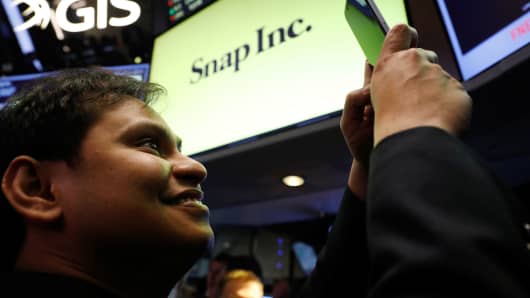Skewed economics further dampen the stock story.
Snap continues spending more on simply hosting user content. It pays third-parties — including Amazon and Google — to use their cloud infrastructure. For a company that brings in $1.53 per user to spend 70 cents per user to simply save that content, it isn't a strategy for ongoing success. Especially when you add in more video content to its roster, these costs can only go up.
That said, some prudent long-term deal revisions late last year have helped somewhat in reducing the costs from a year ago. Overall though, in a typically strong December quarter for ad buys and media spend, Snap's free cash flow stayed negative. That's $197.3 million in negative free cash flows despite raking in $286 million in sales.
CEO Evan Spiegel's lack of experience further underscores Snap's tumultuous public market ride. Far from successfully heading the company to a stronger position on the equity offering boost, his alleged comments about not wanting to grow the user base in poor countries such as India and Spain alienated a lot of people. Its failed attempt at a developing a hardware business with Spectacles didn't help either.
Yes, around the IPO Wall Street painted Speigel as Mark Zuckerberg and Snap as the second coming of Facebook. It's not really accurate, of course, but these comparisons are also where Spiegel and Snap's story gets interesting.
Wall Street keeps trying to revert to a simple narrative to value Snap: It's another social media play, and thus should be compared to the likes of Twitter.
But it's really not — and it has no ambitions of being one either. Snap sees itself as a camera company, and that's not changing. This is key to understanding the potential for Snap's future stock price growth.
By hiring key executives to strategy and finance roles, Speigel showed Wall Street he'll address their concerns — albeit in his own unique way.
Perhaps Wall Street will start to see Spiegel like Elon Musk — a visionary leader leading an innovative company. Because Snap has shown it can be a game-changing tech and media company on the back of Spiegel's ideas.
When the company first came into prominence in 2012, there was no social sharing platform that actually created the content it helped share. Snapchat's camera enabled the early ephemeral "snaps." Five years later and 97 percent of Snapchat's Snaps are created using the camera.
Snapchat's offerings are vertical images and vertical video, and "vertical" is a foreign concept to most of the media ecosystem. Generally, both still and moving images — regardless of screen size — play horizontally, while most mobile phone usage happens vertically. Wouldn't it then be logical for a mobile-only app to have vertical-only media content? Yet no one apart from Snap is this. And advertisers are paying for it.
Snapchat has certain key advantages. It is the only big social sharing platform that has different digital real estate for content from your friends, compared to professional content creators. By not commingling the two, Snap avoids some of the problems dogging Facebook, and also keeps Snap's advertisers away from inadvertently being tagged by undesirable content.
Meanwhile, businesses across the size spectrum are bought in. Snap's advertiser base has grown by leaps and bounds beyond just the top 100 advertisers. Quite unlike Twitter, over 50 percent of Snap's revenue in the December quarter came from advertisers who were outside the Ad Age Top 100.
Snap has also opened the gates for Android users, which means it's better positioned to reach users based outside North America, by reworking their Android experience. The rewards for the move came fast, as daily active users jumped 18 percent to 187 million by December end.
And this doesn't even take into account some of Snap's key future growth opportunities: Shows — it's had success launching shows with millennial-favored networks — and Promoted Stories — which allows brands to craft their narratives in engaging way.
The jury's out on Snap's future as both investors and users eagerly await the re-designed app expected by March-end. Finally, the narrative Wall Street picks will be driven by their belief in Spiegel's ability to out-innovate the competition, and his team's ability to execute the promise of reinventing the media landscape.
Stay tuned.




